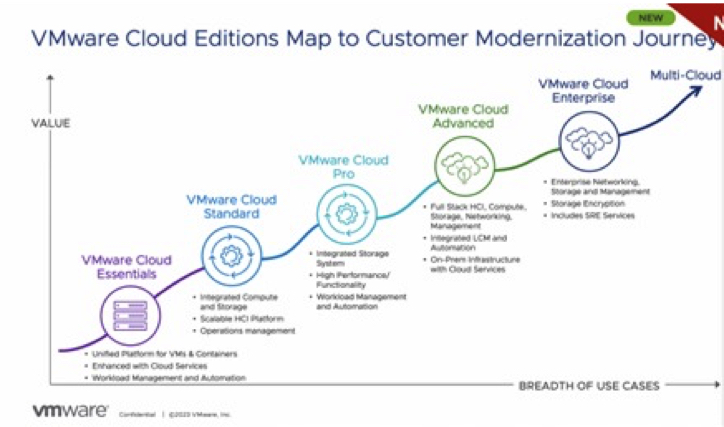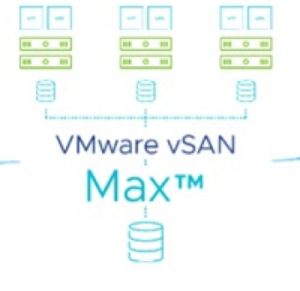Three Technologies with Near-Term Impact Coming Out of VMware Explore 2023
AI, SDS, virtualization
This is a Press Release edited by StorageNewsletter.com on August 30, 2023 at 2:02 pm This article, published on August 28, 2023, was written by Jerome M. Wendt, president and founder, DCIG, LLC.
This article, published on August 28, 2023, was written by Jerome M. Wendt, president and founder, DCIG, LLC.
3 Technologies with Near-term Impact Coming out of VMware Explore 2023
Artificial Intelligence, Software Defined Storage Software, Virtualization
Deep learning VMs. Edge cloud orchestrator. Generative AI. Hybrid multi-cloud. Large language models (LLM). Private AI. VMware AI Labs. vSAN Max.
These terms and many more VMware dropped on attendees at this year’s VMware Explore held this past week in Las Vegas, NV.
While some of these technologies may never impact enterprises, 3 stand poised to impact them in the near-term.
Impact Technology #1: VMware private AI already revitalizing VMware tech support
Trouble shooting and resolving technical issues that arise when managing a VMware environment consume cycles and may disrupt operations. This puts the onus on enterprises, VMware technical support, or both to quickly identify each issue’s root cause(s) and correct it.
This is often easier said than done. Support personnel must first identify the problem.
This process involves:
• Listing out its symptoms.
• Researching the cause of the problem
• Identifying possible courses of remediation and possible actions.
• Implementing the best course of action
These tasks often entail reviewing product documentation, online knowledge bases, and general Internet searches. This may include the need to access data available on the Internet, internal VMware data stores, and behind corporate firewalls.
VMware Private AI provides enterprises with a practical step to address this existing need with its VMware Foundation AI with NVIDIA offering. VMware already internally uses this offering for its technical support staff to help its customers. They use it to diagnose issues, identify possible root causes, and recommend possible actions. Enterprises may also separately license it to build their own AI and high-performance data analytics for their vSphere infrastructure.
Impact Technology #2: VMware Labs provide viable path forward for technical hands-on training
The lack of individuals with the necessary IT skills represented one theme across conferences I attended in 2023. It surfaced again at VMware Explore. VMware anticipates a shortfall of IT professionals running into the hundreds of thousands to support VMware deployments around the world.
This need for VMware technical training was evidenced by comments made by VMware and end users alike during the conference. VMware classifies each organization by how far along each one is on its respective cloud journey. Those organizations just starting on their cloud journey primarily use VMware Cloud Essentials, such as VMware vSphere, NSX, and vSAN. Advanced VMware users utilize its VMware Cloud Enterprise offerings that includes its Site Reliability Engineering (SRE) and Storage Encryption features.

Using these classifications, VMware finds many of its users primarily use its Cloud Essentials offerings. Among them, many use only some of these offerings with vSphere usage representing its largest user base. This observation was validated by one VMware user with which I spoke. He noted his firm had no NSX deployed and few or no vSAN deployments.
The presenter who provided analysts with a tour of VMware onsite lab at the conference also confirmed this observation. She cited that many of the users in attendance take “101” level courses available in its onsite labs on these various Cloud Essential topics.
This lack of knowledge and inexperience with VMware software represents both a challenge and opportunity for VMware. Until organizations become educated in its technology and have staff competent in using it, few will ever move beyond using its Cloud Essentials offerings.
VMware Labs represents a solid stake in the ground that can train and equip users to become proficient in VMware. While labs were available at VMware Explore, VMware also makes some lessons freely available online.
It both educates and equips them to manage VMware’s offerings by offering labs with real-world simulations. By hosting its lab across multiple providers’ clouds, users may become educated and trained in on-premises, cloud, and hybrid deployments. Once subscribed, they may take free and paid classes appropriate to their desires, needs, and/or corporate environment.
Impact Technology #3: vSAN Max ready to assume broader srorage management responsabilities
The need for an enterprise SDS solution has existed for 20 years. This solution must deliver enterprise storage software functionality (LUN masking, replication, snapshots, volume management, etc.) independent of the underlying storage.
This solution may not and often should not replace enterprise storage arrays. Enterprises may still need and want the durability, HA, resilience, and technical support features that these arrays offer. However, performing storage management functions such as data migrations, replication, snapshots, and volume management becomes more difficult at scale.
A network-based SDS solution that resides between the applications and the storage presents a consistent storage interface to applications.
Positioned this way, enterprises may:
• Standardize how they present storage to their applications.
• Often accelerate application performance since the SDS solution often has storage caching.
• Simplify ongoing, back-end storage operations such as data migrations, LUN masking, storage hardware refreshes, volume management, user training, and zoning.

The big obstacle to corporate adoption of this technology has been three-fold.
- Corporate reluctance to move advanced storage management functions off hypervisor and server hosts and storage arrays.
- A lack of trust in a third-party provider to deliver storage management services in an SDS solution.
- The availability of a third-party provider that delivers an enterprise ready SDS solution.
VMware vSAN Max may finally represent an SDS solution that breaks through these 3 historic barriers. With its vSAN offering already used by many enterprises, vSAN Max introduces new levels of performance, scalability, and cost-savings. vSAN Max can scale into the petabytes, offer performance increases of up to 30%, and also reduce TCO by up to 30%.
Available as a disaggregated solution, enterprises do not have deploy vSAN Max as a single instance. They may create multiple, separate vSAN Max deployments to meet specific application needs. However, they may manage them though a single console to obtain the storage management consistency that they seek across their enterprise.














 Subscribe to our free daily newsletter
Subscribe to our free daily newsletter

